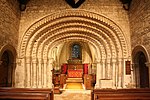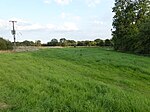Battle of Losecoat Field
1470 in EnglandBattles of the Wars of the RosesConflicts in 1470Edward IV of EnglandEngvarB from September 2013 ... and 2 more
History of RutlandMilitary history of Rutland

The Battle of Losecoat Field (also known as the Battle of Empingham) was fought on 12 March 1470, during the Wars of the Roses. Spellings of "Losecoat" vary, with "Losecote" and "Loose-coat" also seen. The battle secured the defeat of the poorly organised Welles Uprising against King Edward IV, but ultimately led to the defection of Richard Neville, 16th Earl of Warwick and the king's brother George, Duke of Clarence to the Lancastrian cause after they were forced to flee the country having been implicated in the rebellion.
Excerpt from the Wikipedia article Battle of Losecoat Field (License: CC BY-SA 3.0, Authors, Images).Battle of Losecoat Field
Geographical coordinates (GPS) Address Nearby Places Show on map
Geographical coordinates (GPS)
| Latitude | Longitude |
|---|---|
| N 52.686111111111 ° | E -0.53611111111111 ° |
Address
Mounts Lodge
PE9 4DF , Great Casterton
England, United Kingdom
Open on Google Maps









